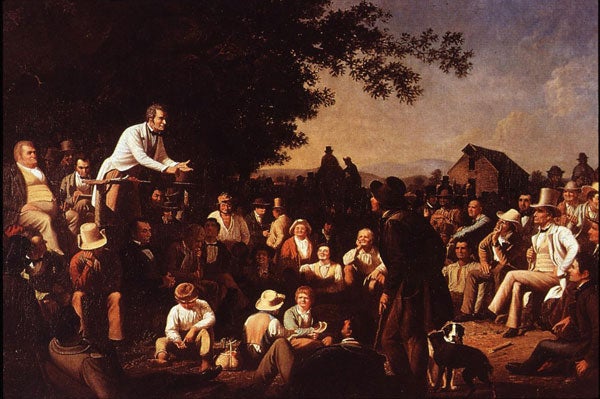Great Work: Stump Speaking (1853-4), George Caleb Bingham
Saint Louis Art Museum, Missouri

How to picture democracy? "If I should need to name, O Western World, your powerfulest scene and show, 'Twould not be you, Niagara – nor you, ye limitless prairies – nor your huge rifts of canyons, Colorado, / Nor you, Yosemite – nor Yellowstone, with all its spasmic geyserloops ascending to the skies, appearing and disappearing, / Nor Oregon's white cones – nor Huron's belt of mighty lakes – nor Mississippi's stream: / This seething hemisphere's humanity, as now, I'd name – the still small voice vibrating – America's choosing day..." declared Walt Whitman in his poem "Election Day, November, 1884".
Which only makes the problem clear. All those grand natural spectacles can be pictured, and they often were, in gigantic canvases by 19th-century American painters. But as for "this seething hemisphere's humanity" and again "the still small voice vibrating" – Whitman implies that, unlike those sublime landscapes, the human power of democracy is invisible. There isn't any particular scene that represents the collective action of all these individual choices. Perhaps that's actually the magic of the vote. It has the force of a seething battle, but works through the still small voice of prayer.
Of course, artists have tried to depict the vote, and it's possible, even though you can't picture the phenomenon all at once. When they've done this, though, what they've shown is something that nowadays may seem strange: the voters themselves. Modern images of Western democratic elections – news, cartoons, propaganda – concentrate on the politicians. They are the protagonists of the process. The electors are in the wings, unseen. In earlier elections and election art they were in the thick of it.
British viewers may think of Hogarth's Election series. Its four scenes are Hogarthian, and all that the word implies: an energetic crowd. They show an election in which the voters are a turbulently physical presence. The series is specifically based on the Oxfordshire election of 1754, celebrated for its extreme corruption, and the electorate is hardly pictured in a favourable light. They are being dined, bribed, menaced, intoxicated, bamboozled, enforced. Everyone is a knave or a fool or an imbecile. One of the electors being carried to cast his vote is actually dead.
Maybe there's a hearty vitality in Hogarth's crowds. Maybe he's heartily disgusted by the proceedings. Either way, you can't say his images remain as relevant today as ever. On the contrary, they are thoroughly alien to modern electoral politics. They present the electorate as an active – an actively culpable – party in the process.
There is another, more enthusiastic vision of the franchise. It was painted a century later by George Caleb Bingham. Bingham – both American artist and politician – made a series of canvases, marking elections in newly created states along the Western frontier. The most encouraging one is Stump Speaking. The electorate is thoroughly male and white, but wider than Hogarth's. There are gentry and farmers, and boys tagging along. An agricultural type asks a question. An orator stands and explains. The gathering laughs.
Yet the whole occasion is far from a rough farce. It's thoroughly anti-Hogarthian in spirit. This is a gathering of stocky, reliable figures, not milling or struggling, but assembling. Apart from the two speakers, everyone is peaceably seated. No one butts in. It's not a confused riot, it's an open-air school room. Apparently casual, the people manage spontaneously to arrange themselves in rows, with each face showing – one man, one vote, so to speak. The organisation is full of verticals and horizontals, giving an orderly clarity.
This is an attentive electorate, unsophisticated but rational, who argue vigorously but non-violently. They may be bored, or not always understand, but they turn up. If in the details the picture's suggests some doubts about people-power, its composition declares an underlying strength in the process. The system is solid. And the voters are shown making most of the going. This is very good picturing of democracy.
The image here is more positive, but no less strange: the voter is so visible. True, among the newly enfranchised nations today, voters can still appear in enormous queues, making an epic out of the franchise. But among the likes of us no voter need meet another voter's eye, or know who did or didn't. A modern Hogarth or Bingham would show just a streetful of anonymists.
About the artist
George Caleb Bingham (1811-79) was a rare combination: a painter of talent and a practising politician. Raised in the frontier land of Missouri River, he was largely self-taught. He's famous for his scenes of manly, everyday life, showing work and play, along the river. His most celebrated picture is 'Fur Traders Descending the Missouri'. He held several electoral positions, and painted banners for the losing candidate in the 1844 presidential election. After an art visit to Düsseldorf, his style became less rustic, and his involvement in post-Civil War politics was more active.
Join our commenting forum
Join thought-provoking conversations, follow other Independent readers and see their replies
Comments